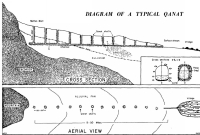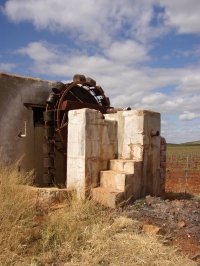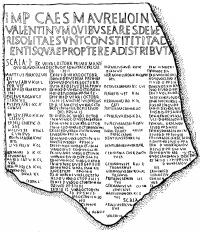


Irrigation
Water was not only a necessity for private consumption but was also needed to grow crops. Most agricultural activities were done based on 'dry-farming': it is striking that ancient writers about agriculture like Cato did not mention mechanical irrigation at all. In arid areas streams were tapped, wells dug and aqueducts built. One of the forerunners of artificial catchment schemes were the qanats. In the early part of the first millennium bc Persians in present Iran started constructing elaborate tunnel systems for extracting ground water from an aquifer. Along the length of these subterranean qanats vertical shafts were sunk at regular intervals. The main outlet was near a village were the water by means of open channels was transported to farming areas for irrigation purposes.|
Qanats (also called karez in Iran, Iraq and Afghanistan, falaz / falaj (plural: aflaj) in Oman, foggara in Libya, Tunisia and Algeria, khettara in Maroc galeria in Spain and turrillas in Andalusia, laoumia in Cyprus)
are subterranean aqueducts engineered to collect groundwater and channel
it to surface canals which direct it to fields and community wells. Qanats appear on the surface as a linear chain of wells, each vertical shaft providing both access to,
and detritus removed from, the galleries. Water seeps through the walls of a mother well, which is sunk into an aquifer upslope from fields being irrigated and is
then carried by gravity through the tunnel to a point hundreds of meters to several kilometers away. When a single tunnel fails to yield, branch infiltration galleries
may be added upslope, or the mother well may be extended deeper into the water-bearing strata. In healthy qanats, flow is continuous, day and night and year to
year, though discharge rates vary as the water table fluctuates throughout the seasons or during periods of drought. Qanat irrigation is a sustainable water recovery method, because it relies entirely on passive tapping of the water table it does not upset the natural water balance, whereas the withdrawal of water by pumping can lead to aquifer depletion. Qanats have greatly influenced patterns of land ownership and tenure, and the socio-economic organization of villages, for it is mostly at the landowner/village level that qanats have been funded, constructed, and maintained. Qanats have been used throughout the Islamic world and as far east and west as Japan and Mexico. In every setting they have had to compete with more modern methods of water delivery. This competition has mostly led to their replacement with diesel and electric pumping devices. Derived from D.R. Lightfoot: Moroccan Khettara: traditional irrigation and progressive desiccation (in: Geoforum, vol 27-2 (1996) pag 261 - 273) |
When necessary water lifting devices were used like the noria's in Spain, the shaduf in the Near East and the screw of Archimedes, but these apparatus were expensive and limited in their capacity to transport water over substantial levels and in large water volumes.
Although there was a constant supply, the water had to be divided among the different farmers which was realized by a system of time-sharing. Known are several inscriptions and documents describing balanced schemes of water distribution in time.
Frontinus recalled the poor quality of the water of the Anio Vetus aqueduct so it was designated for irrigation (Frontinus 92). Talking about the bad quality of the Aqua Alsietina water, he also noted that the surplus of the Naumachia - the main purpose of the construction of this aqueduct - was granted to adjacent properties and for purpose of private irrigation (Frontinus 11.1). According to the same writer, the Aqua Crabra - of which is unknown whether it was an aqueduct or a local brook - watered all villa's in the neighborhood of Tusculum, "the apportionment (was) made by scheduled days in fixed quantities" (9.5), so again an example of time-sharing.
In extreme arid regions in the Near East there were special provisions made to cope with water shortage e.g. 'water harvest area's' near Roman desert forts in present Israel in combination with large cisterns, and dams crossing wadi's to trap soil and water in basins where it could be cultivated.